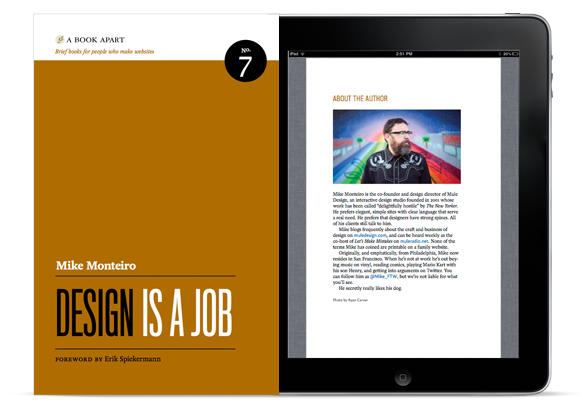Mike Monteiro’s new book, Design is a Job (available April 10th from A Book Apart) is one I wish existed years ago. I needed it. A lot of people needed it, and of course, many still do. It’s a book that should be required reading before being permitted entry to any design school or professional practice: period.
Think of it like this — remember that scene from Monty Python and the Holy Grail (I know, I know [groan]) where the knights must answer three questions before being allowed to cross the Bridge of Death? In this case, to cross, you must first read this book. Then take a test. Then read it again. And then maybe do it all again for good measure.

Throughout the book’s roughly 150 brief, entertaining, and no fluff pages, Mike lays all the cards on the table — face up. He provides simple, clear guidance on how to run not only a successful and profitable design practice, but also one that plays to your team’s or your individual strengths.
There are no claims that this stuff is easy. It’s not. Design is a job. Like any job, you need to work at it to be good. You need to keep working at it to be better, and you need to know when to call in the reinforcements (e.g. the lawyers) when necessary.
That means more than just improving your Photoshop skills. It means learning about business. It means being able to not just communicate and justify your decisions, but to sell them. Your job is to lead, not follow. As soon as you give up the reins on your process, or let a client walk all over you, you’re done for; and as Mike says, ultimately surrender any claim on the title “designer”.
Stop trying to get your clients to “understand design” and instead show them that you understand what they hired you to do. Explain how the choices you’ve made lead to a successful project. This isn’t magic, it’s math. Show your work. Don’t hope someone “gets it,” and don’t blame them if they don’t — convince them.
Throughout the book, Mike consistently reinforces how fear, a lack of shared trust, and misunderstanding your clients’ and your responsibilities are critical failings for so many designers — whether in-house, freelance, or part of an agency of any size. Again, these things aren’t always easy to acknowledge, but success means more than just showing up, it means stepping up. Understanding and doing something about these things are catalysts for change.
While I can relate to, or have experienced nearly everything he discusses in the book during my career, there’s one particular story that resonated with me the most. Mike talks about going to see a client one day and discovering the entire team he was working with was gone. I’ve been there, more than once. It’s not an fun problem, but still one you can both protect yourself, and recover from. Luckily, both our stories had similarly positive outcomes.
If nothing else, the fact that I haven’t stopped thinking about Mike’s book is the sign that it’s not just good, but brilliant. If you think you don’t need this book, you probably do. And if you do think you need it, you definitely need it.
Now, if you’ll excuse me, I’m going to go read it again.
Want a primer on the book? If you haven’t already, watch his, um, colourful Creative Mornings SF talk from March 2011 on, er, getting paid.